This research paper titled Comparing blacksmithing tools from the Mästermyr find with others from Viking Era Scandinavia was the entry of Lady Ása lúfa

This research paper titled Comparing blacksmithing tools from the Mästermyr find with others from Viking Era Scandinavia was the entry of Lady Ása lúfa
Received notice of this article from Academia.edu today. This is a great source of academic research, I always encourage folks to check out.
This is the Quince Marmalade Documentation from the entry of Gisele de la Fontaine
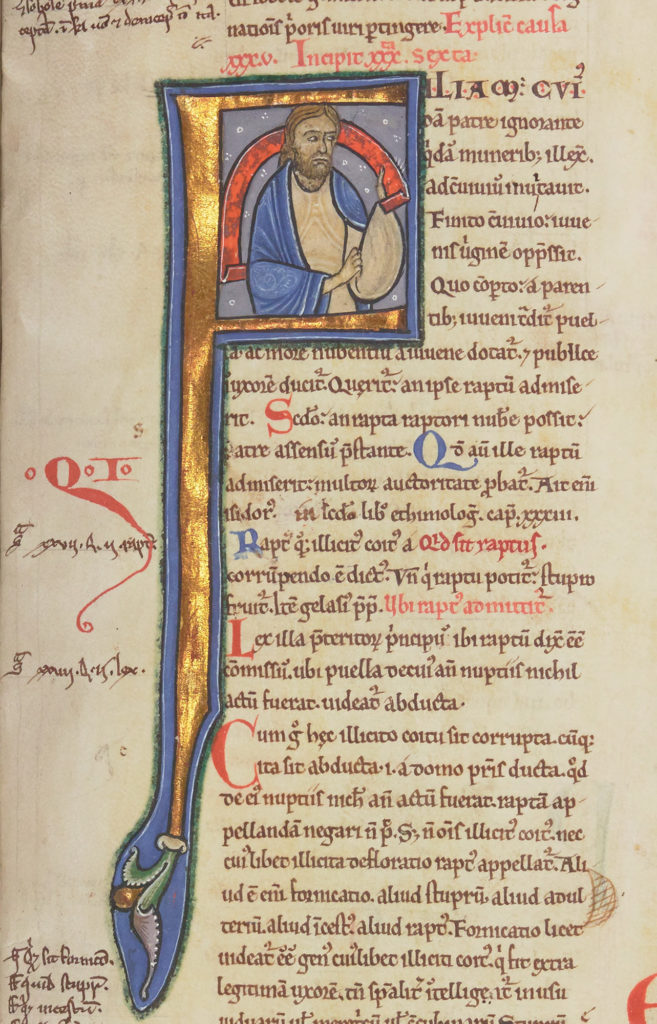 A few months ago the British Library and the Bibliothèque nationale de France made 800 Medieval manuscripts available online. These manuscripts are from the period 700 CE to 1200 CE.
A few months ago the British Library and the Bibliothèque nationale de France made 800 Medieval manuscripts available online. These manuscripts are from the period 700 CE to 1200 CE.
The Bibliothèque nationale de France’s trilingual website allows users to search manuscripts in English, French and Italian.
The British Library website presents a curated selection of these manuscripts.
Bibliothèque nationale de France:
https://manuscrits-france-angleterre.org/polonsky/en
British Library:
Videos courtesy of Mathurin Kebusso
(Apologies to Elaisse de Garrigues; the video of your performance was lost)
These are clips of the complete performances.
Da’ud ibn al-Kabsh al-Garnati al- Mai’ez, called Maaz, “A hakawati style reading of stories and histories of Abd al-Rahman I”
Melanie de la Tour, “Musical Performance (voice and mandolin) of a John Dowland song, Awake Sweet Love”
Pádraigín an Ein i gh, “The Foulest Place of Mine Arse is Fairer Than Thine Face: Them’s Fighting Words, A Demonstration in Taboo Language”
PARENTAL WARNING: This video contains adult language and themes.
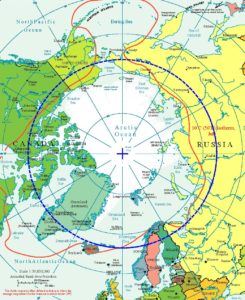 The Scandinavians lived in and colonized places so far north that the time measuring conventions of continental Europe were inadequate. Not only were the days of winter so much shorter than they were further south, the sun barely rose above the horizon, with a track that arched only slightly higher at noon than it did during the rest of the day.
The Scandinavians lived in and colonized places so far north that the time measuring conventions of continental Europe were inadequate. Not only were the days of winter so much shorter than they were further south, the sun barely rose above the horizon, with a track that arched only slightly higher at noon than it did during the rest of the day.
In the rest of Europe, the day was divided into 12 hours of daylight and 12 hours of nighttime. The length of these “hours” varied depending on the time of year. Only on the equinoxes was an hour of daylight 60 minutes long. In other words, on the summer solstice, in Rome an hour of daylight was 76 minutes long using our modern measurements, and an hour of nighttime was 44 minutes long.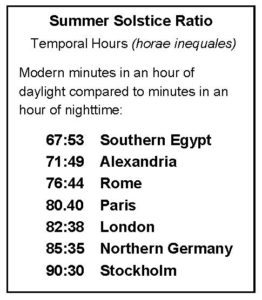
The further north you travel, the longer each hour of daylight becomes. By dividing the hours of daylight into 12 unequal hours, on the summer solstice you end up with a ratio 80 minutes per hour of daylight to 40 minutes per hour of nighttime in Paris, 85 minutes of daylight to 35 minutes of nighttime in northern Germany, 90 minutes of daylight to 30 minutes of nighttime in Stockholm, and 105 minutes of daylight to 15 minutes of nighttime in Reykjavik, Iceland. The reverse was true in the winter, when a daytime hour would measure 30 minutes long in Stockholm and only 15 minutes long in Reykjavik. Clearly the 12-hour convention of southern Europe works poorly in lands nearing the Arctic Circle.
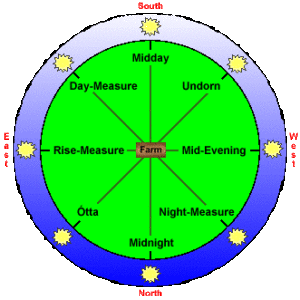 Instead the Scandinavians divided the day into eight equal parts. In the winter the sun would still be below the horizon for much of the day, but “daymarks” (dagmarks) could be measured even during the shortest days of the year. That’s because daymarks relied on the direction of the sun. The Scandinavian system divided the horizon into eight sections by direction (north, northeast, east, southeast, south, southwest, west and northwest).
Instead the Scandinavians divided the day into eight equal parts. In the winter the sun would still be below the horizon for much of the day, but “daymarks” (dagmarks) could be measured even during the shortest days of the year. That’s because daymarks relied on the direction of the sun. The Scandinavian system divided the horizon into eight sections by direction (north, northeast, east, southeast, south, southwest, west and northwest).
Of course the most important daymark each day was noon, when the sun was at its zenith. Known as “Highday” or “Midday” (hádegi or middag), it was the mid-point in the sun’s path across the sky. Unlike the geographic locations of sunrise and sunset, which moved significantly during the year, at midday the sun was in the same place every day.

Equinoctal View of the South Horizon from a Scandinavian Farm
Most Scandinavians used a landmark to identify midday, or highday. There are numerous mountains in Norway named Middagsfjället, Middagshorn and Middagsberg, for example, and in Iceland, Hádegisbrekkur (for highday). Other geographic features used to mark midday were mountain passes, bridges, and fields.
Opposite midday was midnight (miðnætti). In latitudes approaching the Arctic Circle it is easy to establish a landmark for midnight by watching the horizon during June. Although the sun has set before midnight, it is so close to the horizon that the twilight is often bright enough to note where the sun is beneath the horizon. When the sun reaches its lowest point, it is midnight. And of course, at midnight the sun is due north, just as it is due South at noon.

Summer View of the North Horizon from a Scandinavian Farm
Half-way between midnight and midday was mid-morning or rise-measure. This is when the sun is due east. On the equinoxes the sun would rise at this point on the horizon. During the summer the sun would rise long before the nighttime sleep period was over, and during the winter people would wake up long before the sun rose. The sun would rise closer to the midnight marker in the summer and closer to the midday marker in the winter, but the geographic marker for mid-morning would be some feature due east, such as a tree, a valley or another mountain peak. Likewise the point half-way between noon and midnight, mid-evening, was located due west.

Winter View of the South Horizon from a Scandinavian Farm
In between these four cardinal points of the compass were four more geographic markers for times of the day. Between midnight and mid-morning was ótta, roughly 3 am, and between mid-morning and midday was day-measure, about 9 am. After noon was undorn, about 3 pm. And at about 9 pm is night-measure. In all eight directions are used to tell the time, a system that makes sense when the sun is in the sky for wildly different amounts of time during the year. The system uses the location of the sun, whether the sun can be seen above the horizon or not, to tell time.

Summer View of the South Horizon from a Scandinavian Farm
In Anglo-Saxon England during the Viking era, they used a system similar to that of the Scandinavians in that there were eight “tides” to the day. But contact with the Roman Catholic Church and European culture in general led to differences between the English tides and the Scandinavian átts. The English tides don’t seem to be tied to a geographic direction the way the Scandinavian time-telling system was.
For more information on this topic, check out the web page “Telling Time Without a Clock: Scandinavian Daymarks” written for teachers by staffers at the Harvard-Smithsonian Center for Astrophysics. The page is at http://hea-www.harvard.edu/ECT/Daymarks/#3back. Another good online source is “Time and Travel in Old Norse Society,” a paper published by Thorsteinn Vilhjalmsson of the Science Institute, University of Iceland.
Gleaned from Facebook:
In an effort to grow in size and A&S ability, the Shire of Golden Sea is looking for those who would be willing to share their skills and knowledge in classes for their populace. They are looking at holding a scheduled A&S class on the 3rd Saturday of each month in the afternoon.
If you or anyone you know would be willing and able to teach a class (or more than one depending on your comfort level), please email the MoAS at Golden.Sea.Moas@gmail.com
A short survey article of pottery making finds in Northumberland, from prehistory to modern times, including some experimental re-creation. By Richard Carlton. From Academia.edu.
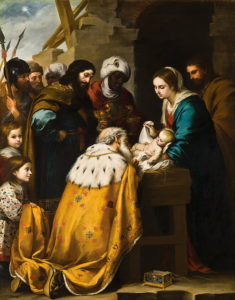
Adoration of the Magi by Bartolomé Esteban Murillo
As it grew dark on Christmas Eve and people filed into church for the Vespers service, the late afternoon/evening service now held around 4 pm, the Christmas season officially began for medieval folk, at least for those in the Christian West.
Unlike us, who begin our Christmas season before the holiday, at Thanksgiving or even earlier, our medieval counterparts began the season with the religious events surrounding Christmas Eve and Christmas Day. Decorations were put up right before Christmas, often on Christmas Eve. I imagine our medieval alter-egos would have frowned on the concept of decorating to celebrate the birth of Jesus before Advent even began.
We live in a secular country that notes holidays like Ramadan and Yom Kippur on its calendars. It’s hard to truly comprehend how much religion and the Christian liturgical calendar were part of everyday medieval life. For the common folk the liturgical calendar was more important than the Julian calendar. Letters were dated by the holy day or week, for example “written on St. Catherine’s Day” or “on the Saturday before Ash Wednesday.” Few used the complicated Roman calendar to date personal correspondence (“vij kalendas Februarias”). Everyone knew when Holy Rood Day or Michaelmas was.
The first day of Christmastide, December 25, was followed by the second day, the Feast of St. Stephen, then the third day, the feast of St. John the Evangelist, and so on. On the evening before the twelfth day of Christmas, January 5, the celebration of Epiphanytide began. The Feast of the Epiphany, which celebrated the visit of the three wise men, or three kings, to the baby Jesus, also celebrated the baptism of Christ during SCA period and to a lesser extent, the miracle at the wedding at Cana. It ended eight days later, on January 13.
Christmas, Epiphany, Lady Day, All Saints’ Day, the feasts of the Ascension of Christ and the Assumption of the Virgin Mary are some of the most important Church holy days, known as Solemnity Days. These days outrank regular saints’ days and memorials. The celebration of Solemnity Days always began the day before, at Vespers.
All these Christian holy days, which is, of course, where our word holiday comes from, were part of the liturgical calendar for the year. Some, like Christmas, were fixed dates. Others, like the first Sunday of Advent, were moveable dates that were computed from when another Church holiday fell on the calendar. Easter, that most complicated Church holiday, determined when many of the other church events took place. I suspect that most people didn’t worry about computing each year’s calendar and simply let their churchmen tell them when to feast and when to fast.
When exactly did Christmas end? Christmastide ended on Twelfth Night. Shakespeare mentions people taking down the Christmas decorations on Twelfth Night. If you include Epiphanytide, you extend the holiday season another week. But in some places they remove Christmas decorations on Candlemas Eve (Feb. 1), and some calendars describe Feb. 1 as the end of the Christmas season. Christians believe February 2 is when Jesus was presented in the Temple and when Mary was purified, so continuing the season of the birth of Jesus until February 2 has some logic to it. However, it seems to be more of a post-SCA period practice.
So what happened after Epiphanytide? The weeks between major Church events were known as Ordinary Time. These weeks were numbered, from one to 34, and usually began the Monday after a significant church time period. For example, Ordinary Time begins on January 14, the day after the end of Epiphanytide, with the first Sunday of Ordinary Time on January 20 this year.
Below is part of a reconstructed medieval liturgical calendar. Since my persona is 12th century English, it represents the holidays and saints’ days my persona would have known.[i] It covers the time from the birth of Jesus to his presentation in the Temple.
Reconstructed Medieval Liturgical Year
Constructed Using 2018-2019 as the Example
Dates marked with (M) are moveable feasts or days of worship. Dates in bold are Solemnity feasts[ii], Church events deemed more important than regular feast days. Optional or obligatory memorial observances are in italic.
| Christmastide (beginning of a week off for the peasantry) | |||
| Christmas/Feast of the Nativity of Jesus Christ | Dec. 25, 2018 | ||
| Feast of St. Stephen | Dec. 26 | ||
| Feast of St. John the Evangelist | Dec. 27 | ||
| Childermas (Feast of the Holy Innocents) | Dec. 28 | ||
| St. Thomas Becket (from 12th century) | Dec. 29 | ||
| Feast of the Circumcision (eight Roman days after Christmas) | Jan. 1, 2019 | ||
| Twelfth Night (eve of the 12th day of Christmas/end of Christmas) | Jan. 5 | ||
| Epiphanytide[iii] | |||
| Feast of the Epiphany (Visit of the Magi/Baptism of Christ) | Jan. 6 | ||
| End of Epiphanytide | Jan. 13 | ||
| Ordinary Time (ordinal – the counted weeks)[iv] | Jan. 14 | ||
| (Begins on January 14 this year) | |||
| First Sunday of Ordinary Time | Jan. 20 | ||
| Second Sunday of Ordinary Time | Jan. 27 | ||
| Candlemas/Feast of the Presentation of Christ/Feast of the Purification of the Virgin | Feb. 2 | ||
[i] Modern liturgical calendars have additional holy days or have removed or added saints’ days. For example, the celebration of the baptism of Jesus is now held on the Sunday after Epiphany in the Roman Catholic Church.
[ii] Solemnities replace Sunday services when they fall on a Sunday. Celebration of Solemnity feasts begins the night before at Vespers.
[iii] Modern church calendars consider Epiphanytide a subset, or part of, Christmastide.
[iv] Ordinary Time runs from the Monday after the Sunday that follows Epiphany (January 13 this year) to the Tuesday before Ash Wednesday (March 5 this year), then resumes on the Monday after Pentecost Sunday (June 10 this year) and concludes before First Vespers of the First Sunday of Advent (Dec. 1 in 2018).
You must be logged in to post a comment.